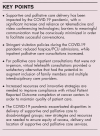Impact of the coronavirus disease 2019 pandemic on delivery of and models for supportive and palliative care for oncology patients
- PMID: 35862890
- PMCID: PMC9451606
- DOI: 10.1097/SPC.0000000000000606
Impact of the coronavirus disease 2019 pandemic on delivery of and models for supportive and palliative care for oncology patients
Abstract
Purpose of review: Supportive and palliative care services have been an important component of the overall COVID-19 pandemic response. However, significant changes in the provision and models of care were needed in order to optimize the care delivered to vulnerable cancer patients. This review discusses the evolution of palliative and supportive care service in response to the pandemic, and highlights remaining challenges.
Recent findings: Direct competition for resources, as well as widespread implementation of safety measures resulted in major shifts in the mode of assessment and communication with cancer patients by supportive care teams. Telemedicine/virtual consultation and follow-up visits became an integral strategy, with high uptake and satisfaction amongst patients, families and providers. However, inequities in access to the required technologies were sometimes exposed. Hospice/palliative care unit (PCU) bed occupancy declined markedly because of restrictive visitation policies. Collection of patient-reported outcome (PRO) data was suspended in many cancer centers, with resulting under-recognition of anxiety and depression in ambulatory patients. As in many other areas, disparities in delivery of supportive and palliative care were magnified by the pandemic.
Summary: Virtual care platforms have been widely adopted and will continue to be used to include a wider circle of family/friends and care providers in the provision of palliative and supportive care. To facilitate equitable delivery of supportive care within a pandemic, further research and resources are needed to train and support generalists and palliative care providers. Strategies to successfully collect PROs from all patients in a virtual manner must be developed and implemented.
Copyright © 2022 Wolters Kluwer Health, Inc. All rights reserved.
Conflict of interest statement
Similar articles
-
Outpatient Palliative Care Practice for Cancer Patients During COVID-19 Pandemic: Benefits and Barriers of Using Telemedicine.Am J Hosp Palliat Care. 2021 Jul;38(7):842-844. doi: 10.1177/1049909121997358. Epub 2021 Mar 4. Am J Hosp Palliat Care. 2021. PMID: 33657873
-
Palliative care experiences of adult cancer patients from ethnocultural groups: a qualitative systematic review protocol.JBI Database System Rev Implement Rep. 2015 Jan;13(1):99-111. doi: 10.11124/jbisrir-2015-1809. JBI Database System Rev Implement Rep. 2015. PMID: 26447011
-
Palliative care provision at a tertiary cancer center during a global pandemic.Support Care Cancer. 2021 May;29(5):2501-2507. doi: 10.1007/s00520-020-05767-5. Epub 2020 Sep 15. Support Care Cancer. 2021. PMID: 32929539 Free PMC article.
-
Harnessing New and Existing Virtual Platforms to Meet the Demand for Increased Inpatient Palliative Care Services During the COVID-19 Pandemic: A 5 Key Themes Literature Review of the Characteristics and Barriers of These Evolving Technologies.Am J Hosp Palliat Care. 2022 May;39(5):591-597. doi: 10.1177/10499091211036698. Epub 2021 Aug 6. Am J Hosp Palliat Care. 2022. PMID: 34355581 Free PMC article. Review.
-
COVID-19 and supportive cancer care: key issues and opportunities.Curr Opin Oncol. 2021 Jul 1;33(4):295-300. doi: 10.1097/CCO.0000000000000729. Curr Opin Oncol. 2021. PMID: 33720066 Review.
Cited by
-
Telehealth Preferences Among Patients With Advanced Cancer in the Post COVID-19 Vaccine Era.J Pain Symptom Manage. 2024 Jun;67(6):525-534.e1. doi: 10.1016/j.jpainsymman.2024.02.572. Epub 2024 Mar 10. J Pain Symptom Manage. 2024. PMID: 38467349 Free PMC article.
-
Telemedical Consultations in Palliative Care: Benefits through Knowledge Exchange and Intercollegiate Collaboration-Findings from the German oVID Project.Cancers (Basel). 2023 Apr 27;15(9):2512. doi: 10.3390/cancers15092512. Cancers (Basel). 2023. PMID: 37173978 Free PMC article.
References
-
- Comart J, Mahler A, Schreiber R, et al. . Palliative care for long-term care residents: effect on clinical outcomes. Gerontologist 2013; 53:874–880. - PubMed
-
- Nordly M, Vadstrup ES, Sjogren P, Kurita GP. Home-based specialized palliative care in patients with advanced cancer: a systematic review. Palliat Support Care 2016; 14:713–724. - PubMed
Publication types
MeSH terms
LinkOut - more resources
Full Text Sources
Medical
Research Materials
Miscellaneous


